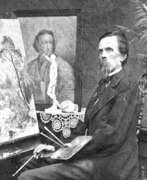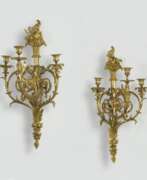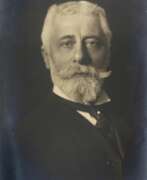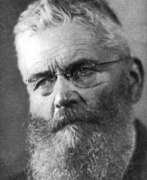Interior designers 19th century
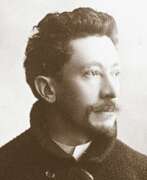

Emile Gallé was a French artist and designer who worked in glass, and is considered to be one of the major innovators in the French Art Nouveau movement. He was noted for his designs of Art Nouveau glass art and Art Nouveau furniture, and was a founder of the École de Nancy or Nancy School, a movement of design in the city of Nancy, France.
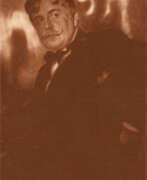

Aleksandr Yakovlevich Golovin (Russian: Алекса́ндр Я́ковлевич Голови́н) was a distinguished Russian artist and stage designer, celebrated for his vibrant and ornate creations in the realms of theatre and fine arts. Born in Moscow in 1863, Golovin initially pursued architecture before shifting his focus to painting, a move that enriched Russian art with his unique blend of symbolism and modernism. His academic journey took him from the Moscow School of Painting, Sculpture and Architecture to the Académie Colarossi in Paris, marking the beginning of a prolific career that intertwined Russian heritage with avant-garde European influences.
Golovin's artistic signature is evident in his stage designs for prominent figures like Sergei Diaghilev, Constantin Stanislavski, and Vsevolod Meyerhold. His work for the original production of Stravinsky's "The Firebird" ballet and the scenic design for Beaumarchais's "The Marriage of Figaro" at the Moscow Art Theatre showcases his ability to blend visual splendor with dramatic storytelling. Beyond the theatre, Golovin's paintings, such as portraits of Fyodor Chaliapin and Vsevolod Meyerhold, and works like "Porcelain and flowers" and "Silver willows," display his mastery over color and form, capturing the essence of Russian culture and the beauty of the natural world.
A figure of national pride, Golovin was honored as a People's Artist of the RSFSR, a testament to his significant contribution to Russian art and culture. His legacy continues to inspire, with his works preserved in the Russian Museum among other collections, serving as a testament to his enduring influence on Russian artistic expression.
For collectors and experts in art and antiques, Aleksandr Yakovlevich Golovin represents a pivotal figure in the evolution of Russian visual arts and stage design. His contributions to both fields remain invaluable, reflecting a unique blend of cultural heritage and innovative artistry. For updates related to Golovin, including new product sales and auction events, signing up for updates offers an exclusive insight into the world of this remarkable artist.


Gustav Klimt, an Austrian Symbolist painter, was a central figure in Vienna's Secession movement, known for his paintings, murals, sketches, and objets d'art. Born on July 14, 1862, in Baumgarten near Vienna, Klimt's early life was marked by financial hardship, but he showed artistic talent at a young age. He studied at Vienna's Kunstgewerbeschule, where he received a conservative education in architectural painting that influenced his early traditional works.
Klimt's path as an artist was evolutionary and controversial. Initially a successful painter of architectural decorations, his style evolved into a more personal and controversial form, especially after public criticism of his works for the Great Hall of the University of Vienna in 1900, which were deemed pornographic. This turning point led him to abandon public commissions and begin the so-called "golden period," characterized by the use of gold leaf in his work. Some of his most famous paintings, such as The Kiss and Portrait of Adele Bloch-Bauer I, which demonstrate a combination of Byzantine influence and modern symbolism, belong to this phase.
An important aspect of Klimt's career was his participation in the Vienna Secession, an art movement he co-founded in 1897. This movement, which had no manifesto, aimed to showcase unconventional artists and to bring foreign artistic influences to Vienna. Klimt was its first president and participated in the creation of the periodical Ver Sacrum.
Despite his artistic fame, Klimt led a relatively withdrawn lifestyle, often working alone and maintaining discreet personal relationships. Nevertheless, his legacy remains strong: his works fetch high prices at auction and continue to be celebrated for their innovative style and symbolic depth.
For collectors and art experts, Klimt's work represents a fascinating exploration of the evolution of Symbolism and Art Nouveau. His unique approach to form, color, and subject matter makes his work highly valued and constantly relevant in the art world.
If you are interested in keeping up to date with sales and auction events related to the works of Gustav Klimt, we recommend signing up for updates. This will ensure that you don't miss the opportunity to own a piece of this remarkable artist's history.
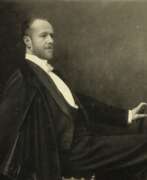

Fernand Khnopff, full name Fernand-Edmond-Jean-Marie Khnopff, was a Belgian Symbolist painter, graphic artist, sculptor and art historian.
Born into a wealthy family, Fernand attended the Royal Academy of Fine Arts in Brussels, where he studied painting with Xavier Mellerie. Throughout his years at the academy, Khnopff spent summers in Paris studying art, and at the 1878 World's Fair he saw the works of Pre-Raphaelite Edward Burne-Jones and Symbolist Gustave Moreau, which had a decisive influence on his work.
In the early 1880s Khnopff began to exhibit his Symbolist works, often inspired by literary works, particularly by Gustave Flaubert. His paintings combined precise realism with an ethereal fairy-tale atmosphere, and he also painted portraits.
In 1883 Khnopff co-founded Les Vingt, a group of Belgian avant-garde artists. From the early 1990s, he collaborated regularly with the Brussels opera house Royal de la Monnaie, designing costumes and sets for many productions. He also designed the interiors of Brussels' landmark buildings: the Maison Stoclet and the Hôtel de Ville in Saint-Gilles.
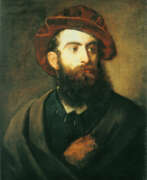

Hans Makart was an Austrian painter of the second half of the 19th century. He became famous as a master of historical painting, still life, allegory, landscape, and portrait. Most of his paintings were painted in the academic style. Makart was also a sought-after stage decorator, costume designer, furniture and interior designer.
Hans Makart was very popular in Vienna, and his studio was a place of attraction for the cream of Vienna's society. After the artist was even named a separate style of art with its characteristic flowing forms and bright colors - "Makartstil". Makart constantly organized grand festivals in his studio, which were willingly attended by members of the imperial family. He made it ultra fashionable to have a new style of interior and soon most of the apartments of wealthy citizens of Vienna were furnished on the model of his salon.
Makart was a professor of historical painting at the Vienna Academy of Fine Arts and head of the Künstlerhaus, the largest exhibition complex in the Austrian capital. In 1879, on the occasion of the silver wedding of the imperial couple, Makart organized a grandiose theatrical performance, the sketches for which have survived to this day.


Sergey Vasilyevich Malyutin (Russian: Сергей Васильевич Малютин) was a distinguished Russian painter, architect, and designer, celebrated for his multifaceted contributions to the world of art and design. Born in Moscow in 1859 to a merchant family, Malyutin's artistic journey began after an exhibition by the Peredvizhniki inspired him to pursue art. His formal education at the Moscow School of Painting, Sculpture and Architecture honed his talents, leading to a diverse career that spanned painting, set design for operas and ballets, and architectural endeavors.
Malyutin is perhaps best known internationally for designing the first matryoshka doll in 1890, a seminal work that has become an iconic symbol of Russian culture. His involvement in the Arts and Crafts Movement influenced his work, integrating traditional Russian folk motifs into his designs and paintings. Notably, his architectural designs, including the Church of the Holy Spirit in Talashkino and the Pertsov House in Moscow, showcase his dedication to the Russian Revival movement, blending fantastic folk motifs with architectural creativity.
Throughout his career, Malyutin also played a significant role in education, teaching at the Moscow School of Painting, Sculpture and Architecture and advocating for Socialist Realism. His contributions to Russian art were not limited to his creations; he was instrumental in founding the Association of Artists of Revolutionary Russia, emphasizing the importance of art in societal development.
For those interested in exploring the legacy of Sergey Malyutin, his works offer a window into the fusion of traditional Russian art with the innovative currents of his time. Collectors and experts in art and antiques will find his contributions to Russian arts and crafts, especially his role in the creation of the matryoshka doll, to be of particular interest.
To stay updated on exhibitions and auction events featuring Sergey Vasilyevich Malyutin's work, sign up for updates. This subscription is an invaluable resource for enthusiasts looking to deepen their understanding of Malyutin's impact on Russian art and design.
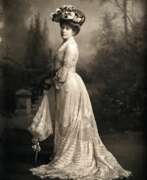

Gwendoline Maud Syrie Maugham was a leading British interior decorator of the 1920s and 1930s who popularized rooms decorated entirely in white.
Although she made her fortune and fame with her white decors, by the mid-1930s she had largely given up the white decors to create interiors with baroque accessories and colour schemes punctuated by bright green, shocking pink, and bold reds.
Maugham's glamorous rooms influenced almost every designer.


Ernst Müller-Scheessel is a German artist and furniture designer.
He worked for a time in Canada - more often in churches as a glass artist. He then taught at the Bremen University of the Arts and co-founded the Bremer Kunstlerbund (Association of Bremen Artists).
In 1910 Ernst Müller-Scheessel opened a studio in the artists' quarter in the center of Bremen and held his first exhibition there in 1913: about 150 works in oil, watercolor and gouache were shown, as well as some of his furniture designs.
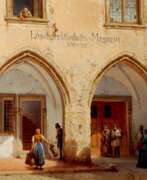

Michael Neher was a German painter and architectural decorator.
Michael studied at the Academy in Munich, in 1819 went to Italy and spent five years there, including two years in Rome, where he studied architectural painting in the studio of the artist Heinrich Maria von Hess, and in 1825 returned to Munich.
As a typical representative of the Biedermeier era, Neher produced many costume drawings and landscapes. He also became famous for his views of public places and architectural depictions of many Bavarian towns. From 1837, Michel Neher devoted himself entirely to architectural painting and traveled to improve his skills along the Rhine and to Belgium. In 1839 he painted several salons in Hohenschwangen Castle from designs by Schwind, Gasner and Schwanthaler. In 1876 he was made an honorary member of the Munich Academy.


Bernhard Pankok, full name Bernhard Wilhelm Maria Pankok, was a German painter and graphic artist, designer, applied artist and architect of the Art Nouveau period.
After acquiring skills as a painter and restorer, Bernhard Pankok studied painting at the Düsseldorf Academy of Fine Arts, then in Berlin. In 1892, he began working in Munich in his own painting studio, doing illustrations for the magazines Pan and Jugend, among others. Pancock was one of the founders of the Munich Association of Art Craft Workshops.
In 1897, Pankok began designing furniture and exhibited his work at numerous exhibitions, including the landmark 1900 "Universal and International Exposition" in Paris. In the same year the art historian Konrad Lange commissioned Bernhard Pancock to design the Haus Lange for him; he worked extensively as an architect in general and designed other buildings in Stuttgart. Pankok was prolific and versatile: he designed sets for opera stages and salons for ocean liners and even the passenger cabins of zeppelins, worked as an architect, furniture designer, interior decorator, painter and graphic artist.
In 1907, he co-founded the Deutsche Werkbund. In 1901 he was invited to teach at the Royal Training and Experimental Workshop in Stuttgart; in 1913 he became its head and in that capacity merged it with the School of Arts and Crafts.
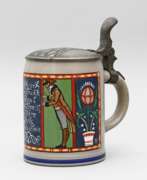

Franz Ringer is a German painter, graphic designer and sculptor.
Franz Ringer came from an old Munich family of carpenters. At the age of 20 he traveled to Tyrol and Switzerland, enrolled at the Technical University of Aachen, returned to Munich and worked as an assistant to the sculptor Josef von Kramer (1841-1908) for ten years, which shaped him as a master stylistically and technically.
Ringer was one of the best-known decorative arts artists in Munich at the time, and he artistically designed many restaurants in Bavaria and in Munich. His design projects are extremely varied.
Franz Ringer is also known as the creator of stone and glass beer mugs, which he painted in Art Nouveau, Art Deco or Biedermeier style. The first Ringer mugs to go into production were made by Villeroy & Boch in 1905. These mugs quickly became popular with the public, especially at scheduled conferences and festivals. Ringer worked for many ceramic manufacturers in Germany. In addition to Villeroy & Boch, these included Reinhold Merkelbach, Merkelbach & Wick, Marzi & Remi, Albert Jakob Thewalt and others.
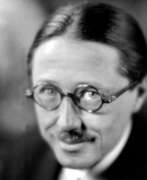

Émile-Jacques Ruhlmann, (sometimes called Jacques-Émile Ruhlmann), was a French furniture designer and interior decorator, who was one of the most important figures in the Art Deco movement. His furniture featured sleek designs, expensive and exotic materials and extremely fine craftsmanship, and became a symbol of the luxury and modernity of Art Deco. It also produced a reaction from other designers and architects, such as Le Corbusier, who called for simpler, functional furniture.
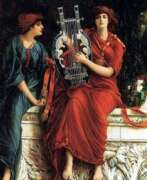

Thomas Ralph Spence was a British architect, painter and sculptor.
Following a family tradition, Spence began his education as an architect, but later excelled in painting, stained glass and metalwork. In 1885 he moved to London, where he became a successful architectural decorator, responsible for decorative painting at Manchester Cathedral. His largest project was St. George's Church in Jesmond, commissioned by Mitchell Senior, it is considered Spence's greatest architectural triumph.
Spence was highly respected as a decorative artist and designer, his stained glass, metalwork and architectural designs were much admired. In 1896 he co-founded the Society of Designers.
Many of Spence's paintings are inspired by the mythology and classical history of Rome, the time of the Punic War. They include scenes of both domestic life and historical events with many participants. He has exhibited with consistent success at the Royal Academy since 1876.
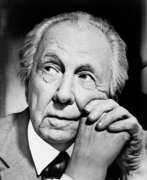

Frank Lloyd Wright was an American architect, interior designer, writer, and educator. He is widely regarded as one of the most important and innovative architects of the 20th century, with a career spanning over 70 years.
Wright is known for his organic architecture philosophy, which aimed to create structures that were in harmony with their natural surroundings. He designed over 1,000 structures, including private homes, public buildings, and commercial buildings, such as the iconic Guggenheim Museum in New York City.
Some of Wright's most famous works include Fallingwater, a private residence built over a waterfall in Pennsylvania, and the Robie House, a Prairie-style home in Chicago. He also designed the Imperial Hotel in Tokyo, which survived the Great Kanto Earthquake of 1923.
Throughout his career, Wright was known for his innovative use of materials, such as his signature use of concrete blocks, and for his emphasis on the relationship between the built environment and the natural world. He also wrote extensively on architecture and design, publishing over 20 books and numerous articles throughout his life.
Frank Lloyd Wright's influence on modern architecture is profound, and his work continues to be studied and celebrated around the world. He is often regarded as a pioneer of modern architecture and a master of American design.
